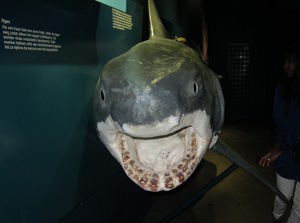As slave mentioned before Algernon Rat visited the Blijdorp Zoo in Rotterdam the Netherlands.
At the entrance there were these big wire and plantmatter Giraffes.
Algernon posed in front of them, can you see him sitting at bottom in the plants?
First thing he visited was the Oceanium of Blijdorp.
Here Algernon poses with some birds that we think live at the Dutch coast.
There was also a shark in the Oceanium. This Shark was kind enough to keep his mouth open while Algernon posed sitting in his beak!!
Did you know that? Sharks have rows of teeth, new teeth are constantly added while old teeth fall out. A tooth will be replaced by a new one, every 8-15 days!
Sharks also have Scales, to be precise Placoid scales, also known as dermal denticles (= 'small tooth'). Studies have found that the scales create tiny vortices that reduce drag, which makes swimming more efficient, as well as quieter compared to bony fishes (source: Wikipedia). A shark will loose up to 20.000 scales a year as it grows, they will be replaced by new (bigger) ones as the shark grows.
Here you can see an actual shark that was lying on top of the Shark tunnel.
We also saw little Nemo, the clownfish hiding... Algernon is on the left
There was also this really big whale, it was not a real one, as it was used by kids to play in (see the kid in white on the right?). Algernon is sitting near the whales eye, near the 'Teeth'. These teeth are actually called Baleen, used to strain seawater for plankton, krill and small fishes.
There was also an Orca, that Algernon wanted us to show you. Algernon is sitting on the Orca's fin.
Algernon also got into the Shark cage, used by people to get close to sharks, but stay safe. Sharks are not that dangerous by the way, of the 375 types of shark only 5-7 types will attack humans. It is said that the chance of getting struck by lightning in the US is 5 times bigger, than to be attacked by a shark.
Slave looooves Mantuas, that are so graceful and as you can see below, that have real smily looking faces...
Algernon took a dive with a turtle in the background
And a big resting fish. Unfortunately slave did not write down what kind of fish is was... Like piggies is also seems to rest on its side :D
Algernon then moved on to a different part of the Oceanium, Here there were Crocodiles, the crocodile in the second pigture below with Algernon are very old! Slave vaguely remembers about reading that then had been in the zoo since after the second world war (1945). She should have written this post earlier! But we guarantee you they were old! Ah, thank god for the Blijdorp website, it says the 2 slender-snouted crocodiles have been there, since 1930 and survived the bombing of Rotterdam.
Back underwater we saw these little Starfish, and he had to have his pigture taken with them...
On the way out of the Oceanium, Algernon saw some huge turtles and this Komodo Dragon. He has a question for us:
How does a (Komodo) dragon kill it's prey?
A. With his sharp claws and teeth
B. They bite their prey, and then wait, it will eventually die of the bacteria in his saliva.
C. with his venom, released when he bites his prey.
The last pigture is one of a Polar bear and two cubs. These are just statues, but the real one, was impressive! Unfortunately we could not get a good pigture of it, as it was behind glass.
Well I hope you enjoyed the post, we really like Blijdorp as a Zoo, and it's close to our home. We have heard however that Subsidy from the rotterdam municipality will be stopped in the near future, which wil very likely mean the end of Blijdorp :(
There is a petition online to keep Blijdorp open: Unfortunately it's in Dutch, it asks for your name, town/city and email adres...





















We think that the Komodo dragon answer is both a and c. Scientists used to think that b was correct but this has been updated.
ReplyDeleteWe tried to sign the petition but are unsure if we have done it correctly!
I found that all of them were correct...
ReplyDeleteEventhough I actually made some up!
but you got me doubting the second answer now, I was told by a collegue who has a dragon at home, that they kill their prey with these bacteria...
He used to work at a snake and lizard/dragon shelter, so I thought he would know.